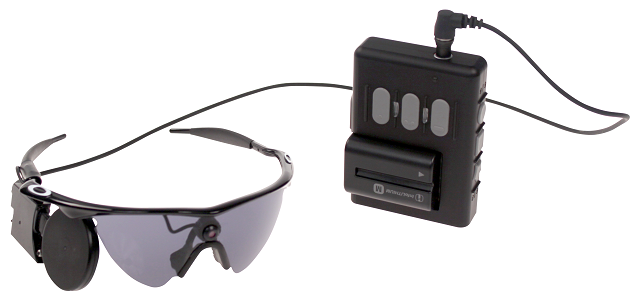Ever since the patient's stroke, she'd been living in impenetrable darkness; tormented by memories of shapes and faces and letters, but powerless to perceive them in the world around her. The nerve cells in her retina, doctors said, were damaged beyond repair.
But when Bill Dobelle flipped the switch on his prototype, his patient gasped in delight: A braille letter, then another, then whole sequences of them, flashed like fireworks across her vision, lighting up the endless black as if by magic. The year was 1974, and William Dobelle had invented the first working visual prosthesis. By electrically stimulating intact visual areas of his patients' brains, he'd found a way to restore sight to the blind -- sight, albeit, of a very limited kind.
As Dobelle continued to refine his devices, problems reared their heads. The process of flashing braille letters one at a time meant that it took ten seconds (or longer) for patients to read a single word. Although the device's six-electrode array was ideally suited to the braille alphabet, it was too low-resolution to render even simple shapes -- let alone whole pages of text. And worst of all, the implant was invasive, requiring an incision deep into the brain. Patients reported infections. Implants had to be excised. And for years, the dream of a visual prosthesis fell dormant.
But this year, a new device may resurrect Dobelle's dream. At Second Sight Medical Products in Sylmar, Calif., a team of neuroscientists and engineers have created a tiny prosthesis that stimulates a patient's damaged retina, which means it can be mounted within the patient's eye rather than within the brain. The implant, named Argus II Retinal Prosthesis System, routes visual information from a head-mounted camera through a wireless transmitter, boasts a higher resolution than Dobelle's device -- 60 electrodes rather than just six -- and is helping patients clock faster reading speeds and higher rates of letter recognition than ever before. This February, the FDA approved the Argus II for nationwide medical use -- and the device has been approved for use in Europe since 2011.

The team at Second Sight say that this prosthesis isn't an end in itself, though, but a step toward a whole new approach to sight restoration. "Now that we're able to parse and render incoming visuals from the patient's environment in real time, we're on the verge of some real paradigm shifts," says Brian Mech, Second Sight's vice president of business development. Only about ten percent of the blind population actually read braille, Mech points out -- so algorithms for real-time image processing are likely to offer more practical benefit than a braille recognition system.
"Even 60 electrodes still provide an extremely low-resolution representation of reality," Mech explains; "but patients can do some pretty amazing things with that -- it appears that their visual cortex can integrate multiple scans of the environment into a single image, and fill in gaps along the way." And Second Sight's latest developments, he adds, could pave the way for additional features like contrast enhancement and improved motion detection. To reach these goals, Second Sight is developing a new type of prosthesis that renders signals based not on the "pixels" of individual electrodes, but on gradients of electrical current between those electrodes. A device like this may offer patients a visual experience of unprecedented resolution, all from a surprisingly small, simple electrode array.
That's not to say, though, that we'll all be wearing reality-augmenting retinal implants within the next few decades. "This type of stimulation is really only useful for patients who've lost their sight," Mech says. "In a healthy visual system, it'd mostly just disrupt existing signals." Besides, he points out, many of the object-tagging features his team is developing are already present in our sensory systems -- it's just that instead of a futuristic visual readout, our inbuilt tags usually take the form of emotional reactions.
Even so, this points back to an unusual effect of prosthetics: They can provide abilities that captivate even the healthiest among us. Powered exoskeletons like the ReWalk device don't just restore mobility to cerebral palsy sufferers - they hint at a near future where super strength is just a button-push away. Echolocation devices offer something like a sixth sense: The ability to "see" in pitch darkness. As prosthetics proliferate, the distinctions between us and our tools continue to blur.
For the present, though, Mech says he's happy just to give some autonomy back to patients who'd given up hope on their sight. "There's a lot of potential with this technology," he says; "but for many patients, even a little 60-electrode array is life-changing." And that's a testament not only to prosthetic technology, but to the extraordinary power of every brain that wields it.